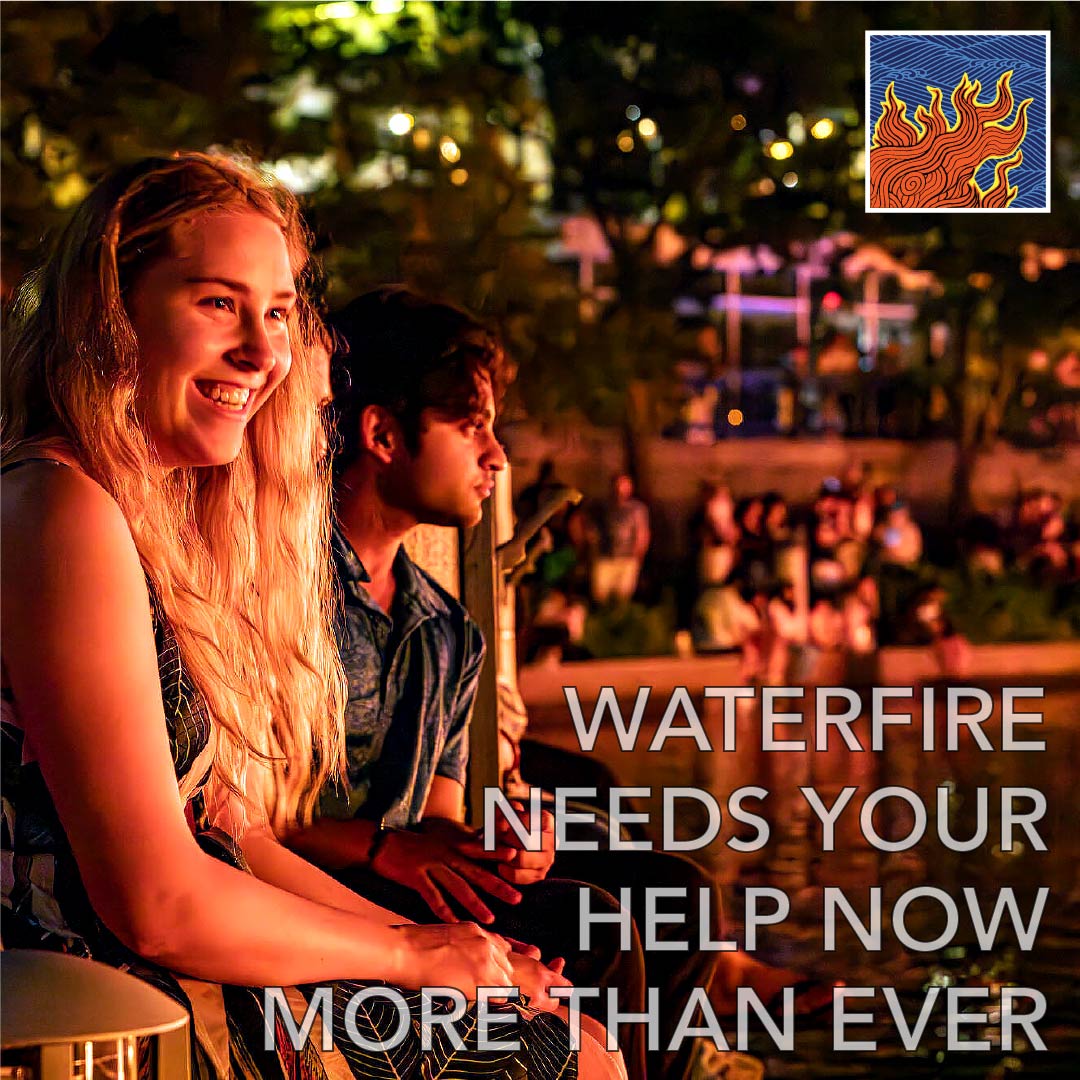Since its inception in 1994, WaterFire has become an international phenomenon, visited by millions, studied and envied around the world. Its creator, Barnaby Evans, has been courted to reproduce this art installation in cities far and wide: earlier this month, Rome, Italy, announced negotiations with Evans to recreate WaterFire along its fabled founding river, the Tiber.
WaterFire is a series of 100 waterborne braziers spaced evenly down the middle of the Providence, Woonasquatucket, and Moshassuck rivers. Rising out of the rivers, and as seen by day, the wire braziers form a curious sequence of empty nests. By night they crackle with 100 log-fed flames, setting the river ablaze with fire and light. A true visual spectacle.
Yet, WaterFire is more than just a visual experience. Accompanying its flames and sparks, it fills the nose with smoky scents of cedar and pine. Emanating from speakers tucked within the river walls, it fills the ear with a spooky mix of music, ambient arias and chants and instrumentals seemingly coming from nowhere and everywhere. WaterFire is a river of light, scent, and sound; meandering, silky, and sensuous, flowing horizontally over time while bonfires rise into space. One doesn’t see WaterFire; one is immersed in it.
The braziers are lit at sundown. As darkness falls, as the fires appear to burn brighter, the music and the flames reflected in the water below turn night ethereal. Normal conversation ebbs. Visitors, transfixed by the torchlit river, gradually fall silent.
The stillness and quiet can be eerie. So many people, so quiet. On any given night of WaterFire tens of thousands will skirt the river or stroll its walks, and yet whether still or moving, the event provokes in visitors a sustained hush: people speak in low voices or whispers or not at all, as though WaterFire is a holy service commanding such muted respect. WaterFire has no rules, no codes of conduct, but somehow, intuitively, collectively, the gathered understand the right to, and delight to, contemplate, meditate, reflect. Visitors have a tacit understanding that they are gathered in the presence of something sublime, and many are struck dumb by it.
This is Hugh Blair writing in 1783 on experiencing the sublime in physical objects.
“It is not easy to describe, in words, the precise impression which great and sublime objects make upon us, when we behold them; but everyone has a conception of it. It produces a sort of internal elevation and expansion; it raises the mind much above its ordinary state; and fills it with a degree of wonder and astonishment, which it cannot well express. The emotion is certainly delightful; but it is altogether of the serious kind: a degree of awfulness and solemnity, even approaching to severity, commonly attends it when at its height; very distinguishable from the more gay and brisk emotion raised by beautiful objects.” (Blair 26)
Sometime in the first century CE Longinus, too, wrote of the sublime, though he addressed himself to the sublime in language. He wrote,
“The effect of elevated language upon an audience is not persuasion but transport. At every time and in every way imposing speech, with the spell it throws over us, prevails over that which aims at persuasion and gratification. Our persuasions we can usually control, but the influences of the sublime bring power and irresistible might to bear and reign supreme over every hearer.” (81)
The objects of the blazing fires produce “the awfulness and solemnity” of which Blair speaks; the mystifying music stands in for Longinus’s “elevated language” and transports the hearer. The two hold visitors spellbound. When at WaterFire, visitors quickly realize they are witnessing something wholly different than anything else they know, participating in something wholly different than anything else they’ve experienced.
And part of that experience is that visitors experience it together, on a grand scale, thousands and thousands of them, from all walks of life and all corners of the world, drawing to river’s edge, immersing themselves in WaterFire’s confluence of symbols, demonstrating Kenneth Burke’s notion of identification, and what he calls the “ambiguities of substance”:
“A is not identical with his colleague, B. But insofar as their interests are joined, A is identified with B. Or he may identify himself with B even when their interests are not joined, if he assumes that they are, or is persuaded to believe so. Here are the ambiguities of substance. In being identified with B, A is “substantially one” with a person other than himself. Yet at the same time he remains unique, and individual locus of motives. Thus he is both joined and separate, at once a distinct substance and consubstantial with an other.” (20)
Whatever else may divide those visitors were they to know it, WaterFire unites them in the common appreciation and appropriation of sight, sound, and moment. There is something very personal and private about sitting on the river wall, gazing upon blazing flames, breathing in the pine scented river air, listening to the low drone of a solo cello, reaching inward as one encounters the outward. Yet, the mystical alchemy conjured by flames and scent and music are not for one, but for all; not for a chosen few but for any who choose. So while visitors may experience themselves transported privately, they do so only through sharing WaterFire publicly.
And no two visitors will experience this encounter the same; for one it may bring a sense of peace, for the other, sorrow. Despite their individual responses, it is the simple act of each experiencing their response alongside the other and before the same fire and touched by the same sounds that ultimately makes WaterFire not simply a community celebration but a celebration of community.
Though there are other aspects to WaterFire – a large open-air dance and other theatrical events, for instance – it is the river and its fires and the artful perturbation of silence the people come to have most. Without them, WaterFire might be just a block party. Fun, “gay and brisk” in Blair’s terms, but mundane.
Part of what makes WaterFire so successful, so moving, is that it allows visitors to discover or witness hierophany, Mircea Eliade’s term describing the phenomenon when a sacred event irrupts out of the profane, spiritually benumbed, spiritually meaningless world. In a sense, hierophanies are divine communiqués in search of an audience, able, like lightning, to strike anywhere. Distinct from simple spiritual revelation, which could be a purely subjective experience, hierophanies occur when something divine reveals itself in a material object – a tree, a rock – “in objects that are an integral part of our natural “profane” world” (11). But in order to see the divine emerge out of the profane, one must be open to it, one must be ready for its manifestation.
Eliade would likely disagree that WaterFire presents a true hierophany, for it is humanly produced and many of its effects effected. Yet the written responses from visitors to WaterFire attest overwhelmingly to having experienced something sacred: “a religious experience”, a “Zen moment”, “calls to mind a Viking funeral or a cremation ceremony along the shores of the Ganges”, a “primal civic rite” (“Comments” npn). That so many visitors have experienced a sense of sacrality proves an objective causal relationship, that such sacred experiences are not just a matter of acausal or a priori subjective revelations. WaterFire causes something spiritual to occur in visitors. They may have come to the event with open hearts and spiritually thirsty souls, but it is the pyres and music that fill those hearts and quench those souls. River, fire, and music provide the physical conduit through which visitors connect to something spiritual. Obviously all will not connect this way, experience WaterFire as a hierophany. But for those who are open to it, the experience is tangible.
More broadly, and less personally, from a rhetorical perspective WaterFire enacts what Michael Halloran and Greg Clark term “the liturgical rites of a civic religion” (147). In their analysis of national parks, they argue that at national parks “objects are held up to public view by rhetorics that transform seemingly mundane things into sacred objects of a “religion” whose purpose is to unite us as a “congregation” of citizens – in short, a civic religion. …Like an experience of the religious sacred, the contact transforms and gives new meaning to ordinary reality” (148).
The kind of unification of which Halloran and Clark speak is largely ideological and narrative: people in private clusters come to America’s national parks to learn in the abstract who “we” are as a people, often based upon who “we” were as a people. Yet, despite the unifying function which national parks serve, those who visit engage them privately or semi-privately, as individuals or small groups, even if those individuals or groups are subsumed within a larger mass, e.g., tourist crowds. The absence or presence of others does not figure into the “rite”: whether 100 people or 1000 people visit Gettysburg on any given day does not change the essentially bilateral meaning of Gettysburg, neither contributing to nor detracting from it. The experience, by design, occurs between the visitor and the symbolic site. Engagement is atomized.
No so for WaterFire. It goes beyond the ideological and the individual. Because it is not merely an exhibition but an event, it unites us physically and intentionally as a congregation not in observance of any shared then but only of a shared now; it makes us present to each other in a way that changes not necessarily how we view ourselves as Americans (because many who visit WaterFire are not), but how we view ourselves as human beings: not as a people, but just people. WaterFire creates an occasion through blazing light and soothing sound where individuals can inhabit a city’s traditional scary places and not feel threatened, not feel defensive by default, not feel the need for a heightened sense of “street smarts.” With guards down, people are free to be recklessly friendly, spontaneously expansive. WaterFire demonstrates the power of a collective community, a congregation able to overcome danger and liberate congregants from isolation and fear. As one visitor wrote, “It is a special night always – a peaceful night – I feel safe enough to come to WaterFire alone” (“Comments” npn).
Special as the night is, WaterFire’s effects, though spontaneous, do not happen by chance. Barnaby Evans conceived the art of WaterFire to encompass not just those elements which he put in place – the mesmerizing fires and music – but also those elements which come serendipitously: visitors. That is, if WaterFire can be likened to a canvas, Evans pictured not only the river and fires within his frame, but all that radiates from them to include the benches and walkways and areas marked off by streets. Visitors never know it, but simply by showing up they step into that frame, become part of the art. They become unwitting accomplices in Evans’s plan to change minds about what a city could be: to have visitors experience the city and each other comfortably, pleasingly, respectfully, and mindfully, as they cozy to the tended fires and scripted music. Having rolled the dice for the first time in 1994, before WaterFire officially became WaterFire, Evans took a chance visitors’ experiences would be positive, that they would come to know the city and each other in ways contrary to routine or expectation. Traditionally a place of brute commercialism, Evans wanted to transform the city, or at least its downtown waterways, into a temple; once inside the temple, people would leave behind the need to compete for the limited material goods of the city but rather partake of the replenishing and inexhaustible spiritual ambience.
If Evans’s first time was a gamble, the second and succeeding times have become sure things, repeated and repeatable proofs of how people can transform and be transformed with and by each other. As such, WaterFire becomes more than a savory, sometimes sacred, art installation: it becomes epideictic rhetoric, reminding visitors on a grand scale of the potential that resides in them. But it is epideictic with a twist: As Chaim Perlman and Lucie Olbrechts-Tyteca define it, epideictic “appeal[s] to common values, undisputed though not formulated, made by one who is qualified to do so, with the consequent strengthening of adherence to those values with a view to possible later action” (53). The twist here is that the “one qualified to do so” and audience are one in the same. Evans may have provided the place for this epideictic display, but it is what “we” do in it that both tests and confirms propositions about who “we” are. Since 1997 WaterFire has consistently allowed visitors to demonstrate time and again much of the best of what they can be with each other, and not just with those they know or when safe within fortifications, but out in public, even in the big, bad city. Especially in the big, bad city, because where else could you assemble tens of thousands of people outside of a stadium or other designed structure? Where else could you prove on such a massive, chance scale humanity’s humanity? WaterFire, by its very presence in the city, refutes one definition of “city”, that of cynical expectations, with proof of what people could come to expect from their cities.
More, the epideictic doesn’t point toward possible later action, or at least not solely: the very act of large crowds engaging WaterFire in the civil ways it calls for enacts the kinds of communal values – respect, courtesy, concern for the other, etc. – in the here and now. That is, through their actions at WaterFire visitors demonstrate conclusively the values which traditional epideictic posits as only “possible.”
Part of what makes WaterFire so special and so magical is the lack of it, its infrequency. It’s an economy of scarcity which helps it to be appreciated so. Occurring only twenty times a year, each evening becomes significant, unique, not to be squandered. Were it to become too regular, frequency and routine would dilute and degrade it. Ho-hum, another WaterFire. It is because it comes as a time-bound opportunity – kairos – and not as a municipal fixture, that it must be understood and responded to as a fleeting gift. And gift it is. There is no charge for admission, not even a gate through which one must walk for entrance. One comes and goes as one wishes. And nothing is asked of the visitor.
But, WaterFire’s success is also its greatest threat. Though the design is for WaterFire to cut through the urban stereotype parting it like the red sea, which includes neutering the business as usual culture (profane), the fact that it eschews business as usual creates opportunistic voids for others to fill. In short, WaterFire attracts commercial parasites. While some may visit WaterFire as a site for prayer, others feed upon it as a site for prey. While Evans had intended the installation as a gift to the city, its people, and its visitors, the crowds it attracts represent market potential for those wishing to feed off of it. The event is ever at risk of kitsch, chatchkas, and cheapening, of vendors exploiting its occasions to sell tawdry things which are not all about WaterFire’s art nor its intended experience. Glo-sticks and other meaningless and unassociated toss-aways must be chased constantly from the scene, reminding us that the paradox which is WaterFire ends across the street, or at 1:00 a.m., whichever comes first.
The atmosphere which Evans and his colleagues work so hard to compose – each WaterFire event goes through a 24 hour cycle, start to finish, relying on approximately 100 volunteers – is finely spun and highly fragile, precisely because it flies against the grain of what a brutal city typically is and does: the sensuousness of the music against the hardness of stone; the scent of pine instead of the smell of exhaust; the truthful impermanence of fire against the false permanence of the skyscraper. Only by continuing as a contradiction to all we might expect at a downtown event can WaterFire maintain its brilliance, burn on. Constructing the kind of sanctuary Evans has in mind, and which visitors gush over, can only be achieved by keeping out those elements which would debase and dissolve it into a quasi-commercial spectacle. Not WaterFire but a parody of WaterFire. Again, in order for WaterFire to work its magic, to create the opportunity for visitors to transport themselves, great effort must be spent protecting the site from those whose only interest is to exploit it and profit from it.
Which points to another bit of invasiveness with the potential to upset the purity of WaterFire, and this has to do not with selling things but with selling privilege. I would argue that part of what makes WaterFire so culturally successful and so communally inspiring – and which lifts it to its epideictic best – is its egalitarianism. There are no reserved spots along the riverwalks for VIPs, no way of telling by location or perch who is wealthy or well to do. Literally, all are on equal footing, side-by-side. Except, that is, for the few unaffiliated excursion boats which serve no function within WaterFire, but which cruise the river carrying passengers for fee who change the egalitarian nature and composition of WaterFire and rupture the river. The fire part of WaterFire needs tending; left unattended, the braziers burn out. Consequently, for WaterFire to extend throughout the night the fires must be fed, and so in service to the art several flat black boats staffed with black-dressed volunteers work unobtrusively as is possible, puttering up and down the river loaded with split wood, feeding the embers. But their role is more than just functional, for as Barnaby Evans explained, he conceived the act of so many tenders each placing a log on the fire to symbolize the work it takes to keep a community alive: many hands each doing some small part (Evans). To the extent that that symbol is to remain uncompromised it must be kept cleared of competing symbols and narratives, or of a composite narrative where some work to uphold the community while others sail around enjoying that work without contributing to it. When a new narrative sails into view, a narrative which symbolizes hierarchy and privilege – some get to ride the boat, most don’t – the communal ideal not only enters into competition with notions of privilege, it is weakened by virtue of its apparent vulnerability: egalitarianism can’t keep privilege out, off the river. And this vulnerability is out of Barnaby Evans’s hands. Though he stated its not as bad today as it was when WaterFire first began, when the river was so thick with boats during WaterFire that one could traverse the river stepping from one hull to the other, still, even as few as one or two boats can temporarily break WaterFire’s magic spell (Evans). At that moment the sublime submerges; the sacred reverts to profane.
WaterFire is a place of temporary transformation. Temporarily, it transforms a city. Temporarily, it transforms the people who visit it. Temporarily it transforms fire into light, water into fire, and music into water. But the dynamics by which these transformations occur are complex and tenuous, and must be protected though constant vigilance. It works because it is unlike other things and allows things to be unlike themselves. WaterFire is a treasured gift and must be guarded.
Works Cited
Blair, Hugh. Lectures on Rhetoric and Belles Lettres. Ed. Linda Ferreira-Buckley and S. Michael Halloran. Carbondale, IL: Southern Illinois University Press, 2005.
Burke, Kenneth. A Rhetoric of Motives. Berkeley, CA: University of California Press, 1950.
Eliade, Mircea. The Sacred and the Profane: The Nature of Religion. Trans. Willard R. Trask. New York, NY: Harper Row, 1959.
Evans, Barnaby. Personal Interview. 29 March, 2006.
Halloran, S. Michael and Gregory Clark. “National Park Landscapes and the Rhetorical Display of Civic Religion.” Rhetorics of Display. Ed. Lawrence J. Prelli. Columbia, SC: University of South Carolina Press, 2006.
Longinus. “On the Sublime.” The Critical Tradition: Classic Texts and Contemporary Trends, 2/e. Ed. David H. Richter. Boston, MA: Bedford/St. Martins, 1998.
Perelman, Chaim and Lucie Olbrechts-Tyteca. The New Rhetoric: A Treatise on Argumentation. Trans. John Wilkinson and Purcell Weaver. Notre Dame, IN: University of Notre Dame Press, 1969.
Jerry Blitefield, PhD, is Associate Professor of English and Director of English Graduate Programs at the University of Massachusetts Dartmouth.
An earlier draft of this paper was delivered to the Eastern Communication Association in Providence, RI, April 28, 2007









